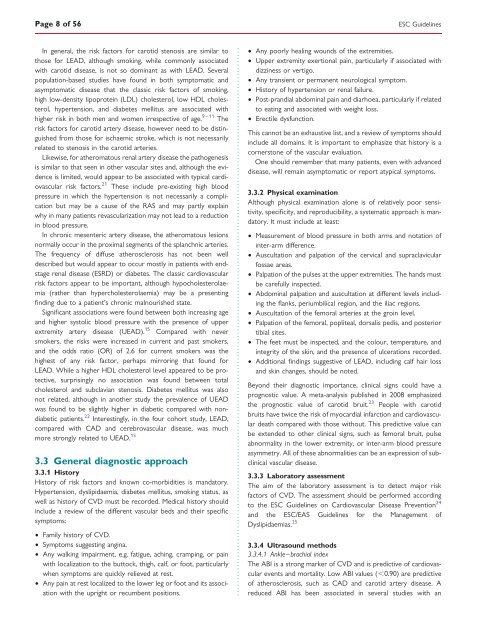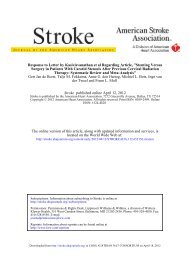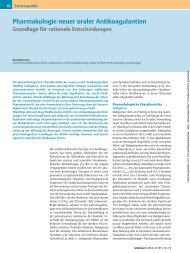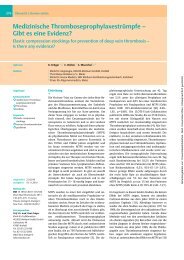ESC Guidelines on the diagnosis and treatment of peripheral artery ...
ESC Guidelines on the diagnosis and treatment of peripheral artery ...
ESC Guidelines on the diagnosis and treatment of peripheral artery ...
You also want an ePaper? Increase the reach of your titles
YUMPU automatically turns print PDFs into web optimized ePapers that Google loves.
Page 8 <strong>of</strong> 56<br />
In general, <strong>the</strong> risk factors for carotid stenosis are similar to<br />
those for LEAD, although smoking, while comm<strong>on</strong>ly associated<br />
with carotid disease, is not so dominant as with LEAD. Several<br />
populati<strong>on</strong>-based studies have found in both symptomatic <strong>and</strong><br />
asymptomatic disease that <strong>the</strong> classic risk factors <strong>of</strong> smoking,<br />
high low-density lipoprotein (LDL) cholesterol, low HDL cholesterol,<br />
hypertensi<strong>on</strong>, <strong>and</strong> diabetes mellitus are associated with<br />
higher risk in both men <strong>and</strong> women irrespective <strong>of</strong> age. 9 – 11 The<br />
risk factors for carotid <strong>artery</strong> disease, however need to be distinguished<br />
from those for ischaemic stroke, which is not necessarily<br />
related to stenosis in <strong>the</strong> carotid arteries.<br />
Likewise, for a<strong>the</strong>romatous renal <strong>artery</strong> disease <strong>the</strong> pathogenesis<br />
is similar to that seen in o<strong>the</strong>r vascular sites <strong>and</strong>, although <strong>the</strong> evidence<br />
is limited, would appear to be associated with typical cardiovascular<br />
risk factors. 21 These include pre-existing high blood<br />
pressure in which <strong>the</strong> hypertensi<strong>on</strong> is not necessarily a complicati<strong>on</strong><br />
but may be a cause <strong>of</strong> <strong>the</strong> RAS <strong>and</strong> may partly explain<br />
why in many patients revascularizati<strong>on</strong> may not lead to a reducti<strong>on</strong><br />
in blood pressure.<br />
In chr<strong>on</strong>ic mesenteric <strong>artery</strong> disease, <strong>the</strong> a<strong>the</strong>romatous lesi<strong>on</strong>s<br />
normally occur in <strong>the</strong> proximal segments <strong>of</strong> <strong>the</strong> splanchnic arteries.<br />
The frequency <strong>of</strong> diffuse a<strong>the</strong>rosclerosis has not been well<br />
described but would appear to occur mostly in patients with endstage<br />
renal disease (ESRD) or diabetes. The classic cardiovascular<br />
risk factors appear to be important, although hypocholesterolaemia<br />
(ra<strong>the</strong>r than hypercholesterolaemia) may be a presenting<br />
finding due to a patient’s chr<strong>on</strong>ic malnourished state.<br />
Significant associati<strong>on</strong>s were found between both increasing age<br />
<strong>and</strong> higher systolic blood pressure with <strong>the</strong> presence <strong>of</strong> upper<br />
extremity <strong>artery</strong> disease (UEAD). 15 Compared with never<br />
smokers, <strong>the</strong> risks were increased in current <strong>and</strong> past smokers,<br />
<strong>and</strong> <strong>the</strong> odds ratio (OR) <strong>of</strong> 2.6 for current smokers was <strong>the</strong><br />
highest <strong>of</strong> any risk factor, perhaps mirroring that found for<br />
LEAD. While a higher HDL cholesterol level appeared to be protective,<br />
surprisingly no associati<strong>on</strong> was found between total<br />
cholesterol <strong>and</strong> subclavian stenosis. Diabetes mellitus was also<br />
not related, although in ano<strong>the</strong>r study <strong>the</strong> prevalence <strong>of</strong> UEAD<br />
was found to be slightly higher in diabetic compared with n<strong>on</strong>diabetic<br />
patients. 22 Interestingly, in <strong>the</strong> four cohort study, LEAD,<br />
compared with CAD <strong>and</strong> cerebrovascular disease, was much<br />
more str<strong>on</strong>gly related to UEAD. 15<br />
3.3 General diagnostic approach<br />
3.3.1 History<br />
History <strong>of</strong> risk factors <strong>and</strong> known co-morbidities is m<strong>and</strong>atory.<br />
Hypertensi<strong>on</strong>, dyslipidaemia, diabetes mellitus, smoking status, as<br />
well as history <strong>of</strong> CVD must be recorded. Medical history should<br />
include a review <strong>of</strong> <strong>the</strong> different vascular beds <strong>and</strong> <strong>the</strong>ir specific<br />
symptoms:<br />
† Family history <strong>of</strong> CVD.<br />
† Symptoms suggesting angina.<br />
† Any walking impairment, e.g. fatigue, aching, cramping, or pain<br />
with localizati<strong>on</strong> to <strong>the</strong> buttock, thigh, calf, or foot, particularly<br />
when symptoms are quickly relieved at rest.<br />
† Any pain at rest localized to <strong>the</strong> lower leg or foot <strong>and</strong> its associati<strong>on</strong><br />
with <strong>the</strong> upright or recumbent positi<strong>on</strong>s.<br />
<str<strong>on</strong>g>ESC</str<strong>on</strong>g> <str<strong>on</strong>g>Guidelines</str<strong>on</strong>g><br />
† Any poorly healing wounds <strong>of</strong> <strong>the</strong> extremities.<br />
† Upper extremity exerti<strong>on</strong>al pain, particularly if associated with<br />
dizziness or vertigo.<br />
† Any transient or permanent neurological symptom.<br />
† History <strong>of</strong> hypertensi<strong>on</strong> or renal failure.<br />
† Post-pr<strong>and</strong>ial abdominal pain <strong>and</strong> diarhoea, particularly if related<br />
to eating <strong>and</strong> associated with weight loss.<br />
† Erectile dysfuncti<strong>on</strong>.<br />
This cannot be an exhaustive list, <strong>and</strong> a review <strong>of</strong> symptoms should<br />
include all domains. It is important to emphasize that history is a<br />
cornerst<strong>on</strong>e <strong>of</strong> <strong>the</strong> vascular evaluati<strong>on</strong>.<br />
One should remember that many patients, even with advanced<br />
disease, will remain asymptomatic or report atypical symptoms.<br />
3.3.2 Physical examinati<strong>on</strong><br />
Although physical examinati<strong>on</strong> al<strong>on</strong>e is <strong>of</strong> relatively poor sensitivity,<br />
specificity, <strong>and</strong> reproducibility, a systematic approach is m<strong>and</strong>atory.<br />
It must include at least:<br />
† Measurement <strong>of</strong> blood pressure in both arms <strong>and</strong> notati<strong>on</strong> <strong>of</strong><br />
inter-arm difference.<br />
† Auscultati<strong>on</strong> <strong>and</strong> palpati<strong>on</strong> <strong>of</strong> <strong>the</strong> cervical <strong>and</strong> supraclavicular<br />
fossae areas.<br />
† Palpati<strong>on</strong> <strong>of</strong> <strong>the</strong> pulses at <strong>the</strong> upper extremities. The h<strong>and</strong>s must<br />
be carefully inspected.<br />
† Abdominal palpati<strong>on</strong> <strong>and</strong> auscultati<strong>on</strong> at different levels including<br />
<strong>the</strong> flanks, periumbilical regi<strong>on</strong>, <strong>and</strong> <strong>the</strong> iliac regi<strong>on</strong>s.<br />
† Auscultati<strong>on</strong> <strong>of</strong> <strong>the</strong> femoral arteries at <strong>the</strong> groin level.<br />
† Palpati<strong>on</strong> <strong>of</strong> <strong>the</strong> femoral, popliteal, dorsalis pedis, <strong>and</strong> posterior<br />
tibial sites.<br />
† The feet must be inspected, <strong>and</strong> <strong>the</strong> colour, temperature, <strong>and</strong><br />
integrity <strong>of</strong> <strong>the</strong> skin, <strong>and</strong> <strong>the</strong> presence <strong>of</strong> ulcerati<strong>on</strong>s recorded.<br />
† Additi<strong>on</strong>al findings suggestive <strong>of</strong> LEAD, including calf hair loss<br />
<strong>and</strong> skin changes, should be noted.<br />
Bey<strong>on</strong>d <strong>the</strong>ir diagnostic importance, clinical signs could have a<br />
prognostic value. A meta-analysis published in 2008 emphasized<br />
<strong>the</strong> prognostic value <strong>of</strong> carotid bruit. 23 People with carotid<br />
bruits have twice <strong>the</strong> risk <strong>of</strong> myocardial infarcti<strong>on</strong> <strong>and</strong> cardiovascular<br />
death compared with those without. This predictive value can<br />
be extended to o<strong>the</strong>r clinical signs, such as femoral bruit, pulse<br />
abnormality in <strong>the</strong> lower extremity, or inter-arm blood pressure<br />
asymmetry. All <strong>of</strong> <strong>the</strong>se abnormalities can be an expressi<strong>on</strong> <strong>of</strong> subclinical<br />
vascular disease.<br />
3.3.3 Laboratory assessment<br />
The aim <strong>of</strong> <strong>the</strong> laboratory assessment is to detect major risk<br />
factors <strong>of</strong> CVD. The assessment should be performed according<br />
to <strong>the</strong> <str<strong>on</strong>g>ESC</str<strong>on</strong>g> <str<strong>on</strong>g>Guidelines</str<strong>on</strong>g> <strong>on</strong> Cardiovascular Disease Preventi<strong>on</strong> 24<br />
<strong>and</strong> <strong>the</strong> <str<strong>on</strong>g>ESC</str<strong>on</strong>g>/EAS <str<strong>on</strong>g>Guidelines</str<strong>on</strong>g> for <strong>the</strong> Management <strong>of</strong><br />
Dyslipidaemias. 25<br />
3.3.4 Ultrasound methods<br />
3.3.4.1 Ankle–brachial index<br />
The ABI is a str<strong>on</strong>g marker <strong>of</strong> CVD <strong>and</strong> is predictive <strong>of</strong> cardiovascular<br />
events <strong>and</strong> mortality. Low ABI values (,0.90) are predictive<br />
<strong>of</strong> a<strong>the</strong>rosclerosis, such as CAD <strong>and</strong> carotid <strong>artery</strong> disease. A<br />
reduced ABI has been associated in several studies with an







